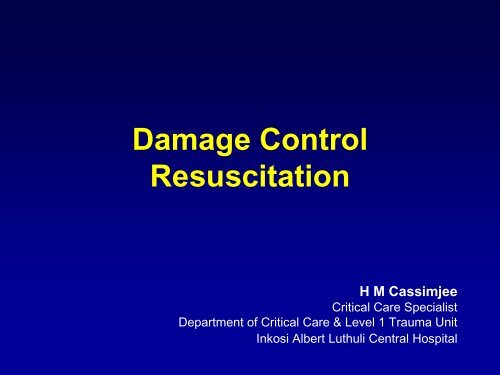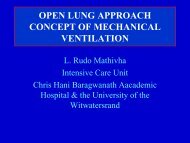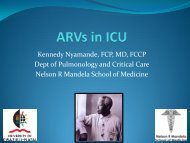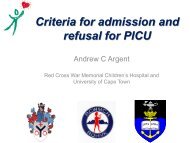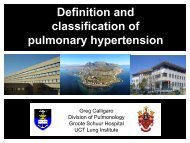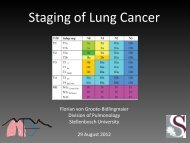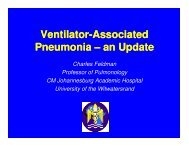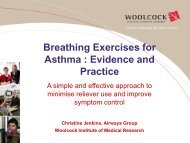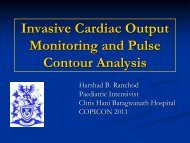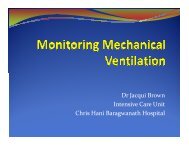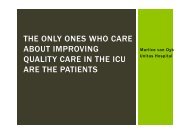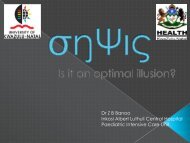Damage Control Resuscitation
Damage Control Resuscitation
Damage Control Resuscitation
Create successful ePaper yourself
Turn your PDF publications into a flip-book with our unique Google optimized e-Paper software.
<strong>Damage</strong> <strong>Control</strong><br />
<strong>Resuscitation</strong><br />
H M Cassimjee<br />
Critical Care Specialist<br />
Department of Critical Care & Level 1 Trauma Unit<br />
Inkosi Albert Luthuli Central Hospital
<strong>Damage</strong> <strong>Control</strong><br />
<strong>Resuscitation</strong><br />
only for<br />
“DAMAGED PATIENTS”
<strong>Damage</strong> <strong>Control</strong> <strong>Resuscitation</strong><br />
• Hypotensive <strong>Resuscitation</strong><br />
• „Haemostatic‟ <strong>Resuscitation</strong><br />
+ Aggressive Warming<br />
• <strong>Damage</strong> <strong>Control</strong> Surgery
Epidemiology<br />
David S. Kauvar, MD, Rolf Lefering, PhD, and Charles E. Wade, PhD. Impact of Hemorrhage on Trauma Outcome:<br />
An Overview of Epidemiology, Clinical Presentations, and Therapeutic Considerations. J Trauma.<br />
2006;60:S3–S11.
Epidemiology<br />
Exanguination :<br />
commonest cause of<br />
DOA<br />
David S. Kauvar, MD, Rolf Lefering, PhD, and Charles E. Wade, PhD. Impact of Hemorrhage on Trauma Outcome:<br />
An Overview of Epidemiology, Clinical Presentations, and Therapeutic Considerations. J Trauma.<br />
2006;60:S3–S11.
31% Mortality for Direct Admissions<br />
2 / 3 DEAD WITHIN 12 HRS<br />
ISS 41<br />
S Afr Med J 2011;101:176-178.
Epidemiology<br />
Sauaia, Angela MD; Moore, Frederick A. MD; Moore, Ernest E. MD et al .<br />
Epidemiology of Trauma Deaths: A Reassessment. J Trauma :38(2), February 1995, pp 185-193
Epidemiology<br />
Heckbert, S R Outcome after Hemorrhagic Shock in Trauma Patients. J Trauma 45(3) 1998, pp 545-549
Epidemiology<br />
8 % of Trauma pts Transfused<br />
3 % of all Trauma pts<br />
± 75% of BLOOD USE<br />
John J. Como, Richard P. Dutton, Thomas M. Scalea. Blood transfusion rates in the care of acute trauma. TRANSFUSION<br />
2004;44:809-813.
Uncontrolled coagulopathic hemorrhage is now the<br />
major cause of potentially preventable death<br />
following trauma.<br />
Hess J R. Editorial. <strong>Damage</strong> control resuscitation: the need for specific blood products to treat the coagulopathy of trauma.<br />
Volume 46, May 2006 TRANSFUSION 685
“Hemorrhage, which produces such terror in the<br />
bystanders . . . . Should never unnerve the<br />
surgeon, who requires all of his self<br />
possession . . . To cope successfully with<br />
this ebbing away of life.”<br />
J.J. Chisolm, Surgeon General, Confederate States of America<br />
Chisolm JJ: A Manual of Military Surgery, for the Use of Surgeons in the Confederate States Army; with an Appendix of the Ruies and Regulations of<br />
the Medical Department of the Confederate States, p 127. Richmond. VA, West & Johnson. 1861.
Ann. Surg. VOl. 197(5):532-535
The innovation of “<strong>Damage</strong> <strong>Control</strong>”:<br />
• Once coagulopathy noted:<br />
– Operation immediately aborted<br />
– Abdominal tamponade effected „Closure under tension‟<br />
– Reexploration when pts blood adequately clotted<br />
Ann. Surg. VOl. 197(5):532-535
93%<br />
MORTALITY RATE<br />
35%<br />
Ann. Surg. VOl. 197(5):532-535
Ann. Surg. VOl. 197(5):532-535
Predicting Mortality<br />
• The “Bloody vicious cycle”:<br />
• Injurity severity score > 25<br />
• pH < 7.10 + systolic blood pressure < 70<br />
• Core temperature < 34°c<br />
When all 3 present: incidence of coagulopathy = 98%<br />
Cosgriff N, Moore E, Sauaia A et al. Predicting Life-threathening Coagulopathy in the Massively transfused Trauma<br />
Patient: Hypothermia and Acidosis Revisited. J Trauma 42(5) 1997. 857-862
The Deadly Triad<br />
hypothermia<br />
acidosis<br />
coagulopathy
“Bloody Vicious Cycle”<br />
Bleeding<br />
<strong>Resuscitation</strong><br />
Coagulopathy<br />
Acidosis<br />
Hypothermia
“Bloody Vicious Cycle”<br />
Bleeding<br />
Depletion<br />
<strong>Resuscitation</strong><br />
Coagulopathy<br />
Acidosis<br />
Hypothermia
“Bloody Vicious Cycle”<br />
Bleeding<br />
<strong>Resuscitation</strong><br />
Coagulopathy<br />
Depletion<br />
Dilution<br />
Acidosis<br />
Hypothermia
“Bloody Vicious Cycle”<br />
Bleeding<br />
<strong>Resuscitation</strong><br />
Coagulopathy<br />
Depletion<br />
Dilution<br />
Dysfunction<br />
Acidosis<br />
Hypothermia
Bleeding<br />
<strong>Resuscitation</strong><br />
Coagulopathy<br />
Depletion<br />
Dilution<br />
Dysfunction<br />
Acidosis<br />
Hypothermia
Bleeding<br />
<strong>Resuscitation</strong><br />
Coagulopathy<br />
Depletion<br />
Dilution<br />
Dysfunction<br />
Acidosis<br />
Hypothermia
J Trauma. 2003;54:1127–1130.
24.4% coagulopathy on admission<br />
Base Deficit > 6<br />
J Trauma. 2003;54:1127–1130.
John R. Hess, Allison L. Lindell, Lynn G. Stansbury, Richard P. Dutton, and Thomas M. Scalea. TRANSFUSION<br />
2009;49:34-39.
Coagulopathy of Trauma<br />
SHOCK / HYPOPERFUSION<br />
Thrombomodulin<br />
Activation of Protein C
Coagulopathy of Trauma<br />
endothelium<br />
TM<br />
APC<br />
THROMBIN<br />
tPA<br />
tPA<br />
tPA<br />
tPA<br />
tPA<br />
tPA<br />
tPA<br />
tPA<br />
tPA<br />
tPA<br />
tPA<br />
tPA<br />
PAI-1<br />
PA<br />
I-1
Fibrinolysis<br />
TRAUMA<br />
Coagulation
•General consensus:<br />
•Early use of RBC + plasma + platelets offers<br />
best chance of limiting coagulopathy
1 : 1 : 1
Dutton RP. Shock Management. Trauma Anaesthesia. Ed Smith CE, Como JJ. Cambridge University press
J Trauma. 2007;63:805–813.
Time to death<br />
2 Hrs<br />
Time to Death<br />
4 Hrs<br />
38 Hrs<br />
Haemorrhage Mortality<br />
Rates<br />
92.5% 78 % 37 %<br />
J Trauma. 2007;63:805–813.
Studies recommending higher plasma : RBC ratios<br />
Stahel PF et al. Transfusion strategies in postinjury coagulopathy. Curr Opin Anaesthesiol. 2009;22:289-298
J Trauma. 2009;66:358–364.
J Trauma. 2010;69: 46–52
J Trauma. 2010;69: 46–52
24 hrs<br />
Heckbert, S R Outcome after Hemorrhagic Shock in Trauma Patients. J Trauma 45(3) 1998, pp 545-549
“Avoid fluids that don’t clot or<br />
carry oxygen !!”<br />
…… R Dutton EMCRIT webcast
J Trauma. 2002;52:1141–1146.<br />
J Trauma. 2011;70: 652–663
Hypotensive <strong>Resuscitation</strong><br />
With judicious fluid administration – not<br />
vasoactive agent use<br />
• Difficult to keep blood pressure at<br />
hypotensive threshold<br />
• “Hypotensive” pts did no worse<br />
• “Hypotensive” pts bled less
Trauma Outcomes<br />
• Avoid fluids that don<br />
ART<br />
Or<br />
SYSTEM
50u BLOOD in 48hrs<br />
Cinat, M. E. et al. Arch Surg 1999;134:964-968.
REPLICATE THIS !!<br />
NOT AN EXERCISE IN FUTILITY !!<br />
69% survival !<br />
P. Hakala et al. Injury, Int. J. Care Injured 30 (1999) 619±622
NOT AN EXERCISE IN FUTILITY !!<br />
HIGHEST PRBC TRANSFUSION<br />
DOCUMENTED IN A SURVIVOR
NOT AN EXERCISE IN FUTILITY !!<br />
HIGHEST PRBC TRANSFUSION<br />
DOCUMENTED IN A SURVIVOR <br />
167 UNITS<br />
> 150 UNITS IN 1 ST 15 HOURS
<strong>Damage</strong> <strong>Control</strong> <strong>Resuscitation</strong><br />
The <strong>Damage</strong> that really matters
The enemy within<br />
“DAMAGED” PATIENTS<br />
DAMPs<br />
<strong>Damage</strong> Associated Molecular Patterns
Vargas-Parada, L. (2010) Mitochondria and the Immune Response. Nature Education 3(9):15
FASEB J. 17, 993–1002 (2003)<br />
Time also matters
<strong>Damage</strong> <strong>Control</strong> <strong>Resuscitation</strong><br />
• Rapid identification:<br />
• “smashed / damaged”<br />
• ABG & INR on admission<br />
• ROTEM / TEG
<strong>Damage</strong> <strong>Control</strong> <strong>Resuscitation</strong><br />
• Rapid identification<br />
• Haemostatic resuscitation:<br />
• Hypotensive resuscitation<br />
• Aggressive re-warming – every drop of fluid<br />
through an in-line warmer<br />
• 1:1:1 if significant blood transfusion considered
<strong>Damage</strong> <strong>Control</strong> <strong>Resuscitation</strong><br />
• Rapid identification<br />
• Haemostatic resuscitation<br />
• <strong>Damage</strong> <strong>Control</strong> Surgery:<br />
• Theatre ASAP: 10 – 15 minutes
BLOOD IS THICKER THAN WATER
Trends in Immunology April 2011, Vol. 32, No. 4


